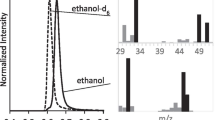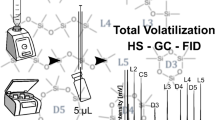Summary
Volatile compounds in various solid samples have been analyzed quantitatively by equilibrium headspace gas chromatography with the technique of multiple headspace extraction (MHE). Solid samples can represent either a partition system, such as certain polymers, or an adsorption system, particularly when present as porous material. It has been found that the humidity of the sample has a strong influence on the equilibration in an adsorption system with a hydrophilic matrix and that the addition of water increases the volatility and speeds up the equilibration time. The influence of various important parameters, such as temperature, time, size and structure of the solid samples on the equilibration is demonstrated on the examples of the quantitative determination of vinyl chloride monomer in PVC, styrene in polystyrene, ethylene in polyethylene, ethylene oxide in a contact lens, halogenated hydrocarbons in coffee and residual solvents in drugs.
Similar content being viewed by others
References
B. Kolb, J. Chromatogr.122, 553 (1976).
J. Drozd, J. Novák, J. Chromatogr.165, 141 (1979).
B. Kolb, M. Auer, P. Pospisil, Angewandte Chromatographie — Applied Chromatography No. 35E (1981), Perkin-Elmer, Überlingen.
B. Kolb, Chromatographia15, 587 (1982).
M. Suzuki, S. Tsuge, T. Takeuchi, Anal. Chem.42, 1705 (1970).
C. D. McAuliffe, U.S.Pat. 3,759,086 (1973).
A. G. Vitenberg, I. L. Butaeva, Z. St. Dimitrova, Chromatographia8, 931 (1975).
A. G. Vitenberg, T. L. Reznik, J. Chromatogr.287, 15 (1984).
W. Closta, H. Klemm, P. Pospisil, R. Riegger, G. Siess, B. Kolb, Chromatogr. Newsletter11, 13 (1983).
B. Kolb, M. Auer, P. Pospisil, J. Chromatogr.279, 341 (1983).
B. Kolb, in “Analysis of Food Contaminants”,J. Gilbert, ed., Elsevier, Amsterdam, 1984, p. 117.
A. R. Berens, L. B. Crider, C. J. Tomanek, J. M. Whitney, J. Appl. Polym. Sci.,19, 3169 (1975).
H. Hachenberg, A. P. Schmidt, Gas Chromatographic Headspace Analysis, Heyden & Son, London, 1977, p. 12.
M. Auer, P. Pospisil, partially presented at the “Anwender-Kolloquium über die Gaschromatographische Dampfraumanalyse”, Bad Nauheim, 3./4. Oktober 1983.
F. A. Bencsath, K. Drysch, D. List, H. Weichardt, Angewandte Chromatographie — Applied Chromatography, No 32E (1978), Perkin-Elmer, Überlingen.
B. Kolb, P. Pospisil, Chromatography Newsletter,8, 35 (1980).
Author information
Authors and Affiliations
Rights and permissions
About this article
Cite this article
Kolb, B., Pospisil, P. & Auer, M. Quantitative headspace analysis of solid samples; a classification of various sample types. Chromatographia 19, 113–122 (1984). https://doi.org/10.1007/BF02687726
Received:
Accepted:
Issue Date:
DOI: https://doi.org/10.1007/BF02687726




